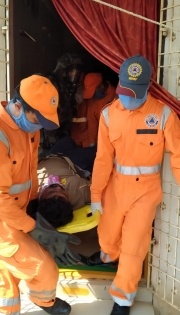Did prolonged storage of styrene during lockdown led to leakage?
By IANS | Published: May 7, 2020 06:42 PM2020-05-07T18:42:00+5:302020-05-07T18:55:41+5:30
The gas leakage that occurred early Thursday at LG Polymers plant here leading to death of 11 people may have been caused by initiation of polymerisation of styrene in liquid form due to prolonged storage during the lockdown period, officials said.Officials also believe that the safety system failed to prevent gasification of styrene, resulting in its leakage and spread of the gas to the surrounding villages on the outskirts of Visakhapatnam.The leakage happened from a 2,500 kl tank, which had 1,800 kl styrene in liquid form."Styrene in liquid form is safe when stored at below 20 degrees but due some technical problem, the refrigeration was not effective leading to rise of temperature and Styrene started gasifying and the leakage happened," he said The Collector explained what could have caused the leakage to Chief Minister Y.

Did prolonged storage of styrene during lockdown led to leakage?
The gas leakage that occurred early Thursday at LG Polymers plant here leading to death of 11 people may have been caused by initiation of polymerisation of styrene in liquid form due to prolonged storage during the lockdown period, officials said.
While a final report is awaited on what actually caused the disaster, the preliminary investigations indicate that polymerisation was initiated in one of the two tanks due to prolonged storage.
The disaster happened as the plant was re-starting its operations after more than 40 days due to the lockdown.
Officials also believe that the safety system failed to prevent gasification of styrene, resulting in its leakage and spread of the gas to the surrounding villages on the outskirts of Visakhapatnam.
Eleven people were killed as a result of the leakage which happened around 3.45 a.m. Officials said 340 people had to be admitted to hospitals. The condition of 15 of them is critical.
According to Visakhapatnam District Collector V. Vinay Chand, the company had stored styrene in liquid form in two tanks of 2,500 kl and 3,500 kl capacity. The leakage happened from a 2,500 kl tank, which had 1,800 kl styrene in liquid form.
"Styrene in liquid form is safe when stored at below 20 degrees but due some technical problem, the refrigeration was not effective leading to rise of temperature and Styrene started gasifying and the leakage happened," he said
The Collector explained what could have caused the leakage to Chief Minister Y. S. Jagan Mohan Reddy, who air-dashed to the city to call on the affected people at King George Hospital.
"At the time of the accident between 3.45 a.m. and 5.45 a.m. concentration of styrene was extremely high. We could not measure at that time because we could not enter villages," said the Collector.
When measured at 9.30 a.m., the concentration of styrene in the air was 1-2.5 parts per million. Later, the concentration increased further. "We need to monitor it on 48 hours basis before we come to a conclusion that it is safe for people to return to the villages," he said.
Styrene is an organic compound and volatile organic compound meter is required to measure its concentration in ambient air.
The Chief Minister was informed that emissions were continuing from the tank. The authorities were waiting for a chemical which acts as an antidote to cut the chain of polymerisation.
They will sprinkle water to bring down the temperature and simultaneously use the antidote.
Officials expect that after emissions reach to zero level, it may take 12-24 hours for them to declare the villages safe for people to return.
( With inputs from IANS )
Open in app